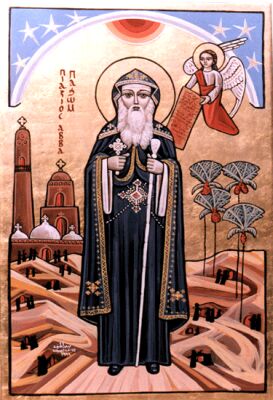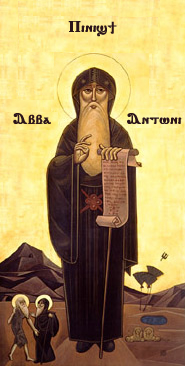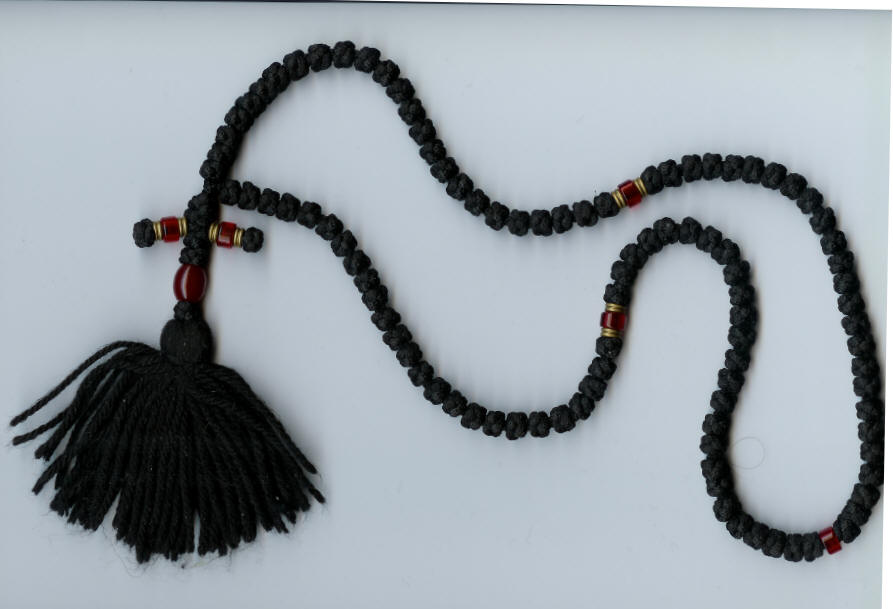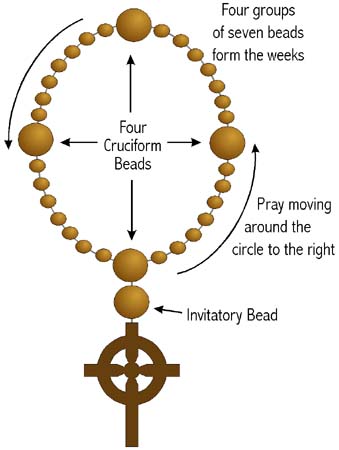In my first post on this topic, I explained the reason behind Christian prayer beads, why we use them, their origin in ancient Christian times, and why they in no way contradict Scripture. In my second post on this topic, I explained different methods of using Rosary Beads along with various devotions, ranging from the simple Jesus Prayer Chaplet, to the complex Holy Rosary devotion. In this post I’ll briefly discuss the Jesus Prayer Chaplet, otherwise known as Anglican Prayer Beads.
Some Catholics might have an aversion to the Jesus Prayer Chaplet, or Anglican Prayer Beads, which most likely originates in the word “Anglican.” In truth, they’re only called Anglican Prayer Beads because they were invented by Anglicans in the State of Texas. They’re not particular to Anglicans and they never really were. This particular bead configuration has been used by Lutherans, Methodists, some Catholics and various Evangelicals partial to prayer-bead devotions. One could just as easily call them “Texas Prayer Beads” in reference to their geographical origin, or “Christian Prayer Beads” in a general sense based on who uses them, or “Jesus Prayer Beads” in reference to the common devotion used on them. I think the term “Anglican Prayer Beads” just stuck because Anglicans were the first to use them.
I suppose for Catholics the first question to answer would be: is it okay to use them? The answer to that is a simple yes. They’re just beads. They don’t bite, and they don’t make you Anglican. (No more than praying on Rosary Beads makes you Catholic.) For some Protestant objections to using prayer beads, or repetitive prayer, see my rebuttal here.
There is no Catholic rule that says you have to use a certain configuration of beads. The Holy-Rosary Bead Configuration is the most popular in the Western World, especially among Catholics, but that doesn’t mean that other bead configurations are somehow “wrong” or “inappropriate” for Catholics to use. Prayer is prayer, and if you choose to use Rosary Beads, good for you. But if you choose to use some other bead configuration, that’s okay too. Just for the record, I’m a Catholic, and I use both Rosary Beads and the Jesus Prayer Chaplet. Why? Because I want to. And that’s reason enough. What matters is that I’m praying to God and invoking his Holy Ones (Saints). What manner of bead configuration I use is rather unimportant.
In my second essay on this topic, I pointed out that Rosary Beads are only necessary for the Holy Rosary devotion. I reassert that here. You can’t do a Holy Rosary Devotion properly on the Jesus Prayer Chaplet. It just won’t work. The bead configuration is all wrong for that. The same is true for the Five Wounds Chaplet. But if you’re not doing the Holy Rosary devotion, or the Five Wounds Chaplet, then the bead configuration becomes less important.
Many people are under the impression that the Jesus Prayer Chaplet is popular among Catholics within the Ordinariates of English Patrimony, what with them being formed by converts from Anglicanism and all. That’s not true. Most of the converts to Catholicism (from Anglicanism) within the Ordinariates, tend to use the Rosary Bead configuration. That’s because these people were mostly Anglo-Catholics before joining the Catholic Church, and most of them left The Episcopal Church in the United States a generation ago, just before the Jesus Prayer Chaplet was invented. Their connection to Rosary Beads goes all the way back to the middle 20th century. They just never took an interest in the Jesus Prayer Chaplet devotions. As for me, on the other hand, I was an Episcopalian in the 1990s prior to becoming Catholic. My first experience with prayer beads was the Jesus Prayer Chaplet and the various devotions associated with it. So I’m very familiar with it and still use it on occasion. While I tend to always carry a Rosary around with me, and use it quite frequently, I will occasionally switch to the Jesus Prayer Chaplet, if for no other reason than nostalgia. My point here is it’s perfectly safe and permissible for Catholics to use the Jesus Prayer Chaplet if they want to.
The truth is Catholic prayer beads come in various arrangements. Like I said, the Rosary-Bead configuration is the most common, consisting of five strands of ten beads, but Catholics have other prayer-bead configurations as well. There’s the Chaplet of the Seven Sorrows, which consists of seven strands of seven beads. Then there’s the Chaplet of St. Michael, which consists of nine strands of three beads. There is also the Padre Pio Chaplet, which consists of three strands of five beads. Of course, there is also the St. Joseph Chaplet, consisting of fifteen strands of three beads. There is also the Little Crown of the Blessed Virgin Mary Chaplet, consisting of three strands of four beads. Need I go on? Catholics have a long history of using various prayer-bead configurations for various different types of devotions. So it would appear that the Jesus Prayer Chaplet has become just one more configuration.

Christians began using repetitive prayer devices in Christian Egypt, during the early fourth century (between AD 300 to 350), long before Muslims forcibly took over the region, and the practice is attributed to Saint Pachomius the Great (pronounced: Pak-ho-mee-oos). According to historical record, he developed the discipline using knotted ropes for illiterate monks to use in place of reading from liturgical books, psalms and prayer manuals. The knots on the rope were used to help them accomplish a consistent number of prayers and prostrations throughout the day. Prior to the development of the knotted rope, illiterate monks would count their prayers by dropping pebbles into a bowl. The knotted rope method was far more portable and practical. The devotional lives of religious monks was/is filled with prayer constantly throughout the day and well into the night. This is in accordance with the Biblical admonition to pray without ceasing (1 Thessalonians 5:17) which Eastern-Christian monks took very seriously and literally.

It is said that Saint Anthony the Great, a contemporary of Saint Pachomius, who also lived in Egypt, devised the method of tying the rope into tiny knots in the shape of seven crosses, overlapping each other into a larger knot that looks like a ball. The knots of Eastern Christian prayer ropes are still tied this way today.
The prayer rope devotion is fairly simple and used by Eastern Christians to this very day: among the Eastern Orthodox, Egyptian Coptic, and Eastern Catholics. Depending on the length of the rope, it can consist of 33, 50 or 100 knots. Historically, the 100-knot rope was common among Eastern monks, but shorter versions of the rope developed later as laypeople began taking up the practice. The smaller rope was for practical purposes, to easily fit into a pocket. or wrap around the wrist in a practical way. Traditionally, wearing the prayer rope around the wrist, when not in use, was the most common method of carrying it, as a constant reminder to the devotee that one should pray without ceasing. That being said; prayer ropes, prayer beads and rosaries should never be worn around the neck like jewelry. They are religious tools and spiritual weapons, not decorative fashion-statements. When not in use, they should be kept in a pocket, worn on a belt, or wrapped around the wrist. They should always be thought of as tools not jewelry. The Eastern Christian prayer rope is usually tied into a circle in the shape of a large cross, and below the cross is a tassel, which connects to the Jewish heritage of Christianity. Jews were commanded by the Mosaic Law (Torah) to wear tassels on their clothing, and Jews still practice this today with a prayer shawl called a tallit. So likewise, in memory of this ancient command to the first people of God (the Jews), Eastern Christians would tie a tassel to the end of their prayer ropes. It is said that these were tassels are also used for wiping away tears when praying.

The knots themselves don’t mean anything. They are simply place markers, to help the devotee count his/her prayers, without having to think about what number he/she is on. The same is true with all prayer-bead devotions. The knots or beads have no special meaning. They’re simply used for counting, without having to mentally keep track. On the Eastern-Christian, Prayer Rope, the prayers prayed on each knot are fairly simple and repetitive. One type of devotion is the Jesus Prayer: “Lord Jesus Christ, Son of God, have mercy on me, a sinner.” This is prayed over and over again on each knot. Another type of devotion is Kyrie Eleison, which is the Greek way of simply saying “Lord, have mercy.” This too can be prayed over and over again on each knot.
The Jesus Prayer Chaplet appears to have originated in the Episcopal Diocese of Texas sometime in the 1980s. The diocese covers part of southeast Texas. The original, and most popular, devotion used on these beads appears to be based on the Jesus Prayer Rope used by Eastern Orthodox and Eastern Catholic Christians. There seems to have been a conscious effort to merge Eastern Christian devotion with the use of Western-style prayer beads. To be fair, this is probably how prayer-bead devotion originally came to Western Europe about a thousand years ago. It’s just that the Holy Rosary devotion, with its specific Rosary-bead configuration, became so overwhelmingly popular in Western Europe after AD 1214 that all other prayer-bead configurations and devotions took a backseat in the West. The original prayer beads in Western Europe probably looked like a single strand of anywhere between 10 to 100 beads. The Jesus Prayer Chaplet attempts to recreate this, but with a more symbolic form.

The beads are arranged into four strands of seven beads called “weeks” for the seven-days of the week. Seven times four is twenty-eight, so one full loop around the prayer beads is called a “month” (four weeks to a month) in recognition of a lunar month being about twenty-eight days on the ancient lunar calendars. Between each “week” is a “cruciform” bead, in reference to the cross. Functionally, they simply divide the “weeks” into four equal strands, but when laid out on a table, and connected with imaginary lines, they form the shape of a cross. The last bead is the “invitatory” bead, which is a reference to an “invitation” to pray. At the bottom of the Jesus Prayer Chaplet is a simple cross, or some other type of Christian medal, just like one would find on a typical Rosary-bead chain/cord. All together, there are exactly 33 beads on this chaplet, one bead for each year of our Lord Jesus’ earthly life, as tradition holds. If you would like to order this arrangement of prayer beads, simply click here.
The original devotion is simple enough. It goes like this…
On the Cross: Make the sign of the cross, praying…

“In the Name of the Father, and of the Son, and of the Holy Ghost. Amen.”
On the Invitatory Bead:
O God make speed to save me (us),
O Lord make haste to help me (us),
Glory be to the Father, and to the Son, and to the Holy Ghost: As it was in the beginning, is now, and ever shall be, world without end. Amen.
On the Cruciform Beads:
Holy God,
Holy Almighty One,
Holy Immortal One,
Have mercy upon me (us),
And on the whole world.
On the Week Beads:
Lord Jesus Christ, Son of God,
Have mercy on me, a sinner.
After completing one “month,” you may exit the Jesus Prayer Chaplet by going to the Invitatory Bead, or continue around again for a second and/or third “month.”
On the Invitatory Bead on the way out:
Our Father, who art in heaven,
hallowed be thy Name,
thy kingdom come, thy will be done,
on earth as it is in heaven.
Give us this day our daily bread.
And forgive us our trespasses,
as we forgive those who trespass against us.
And lead us not into temptation,
but deliver us from evil. (Amen)
Here you may add the doxology…
For thine is the kingdom,
and the power, and the glory,
for ever and ever. Amen.
On the Cross:
I bless the Lord.
OR
Let us bless the Lord
Thanks be to God.
OR
In the Name of the Father, and of the Son, and of the Holy Ghost. Amen.
If this particular devotion is used, then it’s not really so much “Anglican Prayer Beads” but rather a “Jesus Prayer Chaplet” based on the Eastern devotion of the Jesus Prayer Rope, and it would be perfectly acceptable (to everyone really) if it’s called that, provided its used for this purpose.
There are, however, multiple other devotions people use on these prayer beads which I won’t go into here. Indeed, entire books have been written on it (see here, here and here). For Catholics and Evangelicals, it’s probably best to stick with the Jesus Prayer Chaplet, but from what I’ve seen of other devotions, they’re usually harmless and some are quite good. I usually did the Jesus Prayer Chaplet when I was an Episcopalian, and that’s the one I go to whenever I pick up my old Anglican Prayer Beads.
Some Jesus Prayer Chaplets are designed as a bracelet, which is an appropriate way to carry them based on Christian tradition. They’re too small to wear around the neck, so we never have to worry about them being used as necklaces, which is an inappropriate way to carry prayer beads anyway. Prayer beads are religious tools and spiritual weapons. They’re not jewelry. So they should be carried in the hand, on the wrist, in the pocket or purse, but not around the neck for show. Get yourself a good cross or pendant for that.
I predict the use of the Jesus Prayer Chaplet will see an uptick in the future. They’re never going to have the same popularity as Rosary Beads, or the Holy Rosary Devotion, but they will be used both by Catholics and Non-Catholics alike, either occasionally or regularly. I think this is namely because the beads represent an attempt to merge East and West into a singular devotion that is small, portable, and easy to carry. Their simplicity is appealing, and their symbolism is beautiful. The nice thing about them is they’re the type of prayer beads Catholics and Protestants can easily pray together, especially the Jesus Prayer Chaplet, without any danger of theological or doctrinal compromise on either side. By taking the use of prayer beads back to their most ancient roots (the Jesus Prayer Rope) Catholics and Protestants can find a little common ground on contemplative prayer in the Anglican-inspired, Jesus Prayer Chaplet.
RELATED…
Shane Schaetzel is an author of Catholic books and an Evangelical convert to the Catholic Church through Anglicanism. His articles have been featured on LifeSiteNews, The Remnant Newspaper, Forward in Christ, and Catholic Online. You can read Shane’s books at ShaneSchaetzel.Com


You must be logged in to post a comment.